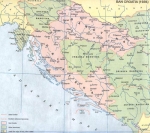The arrival and settling of Slavs in the region of the present-day Bosnia-Herzegovina. During that period, the Slavs have, following the assimilation of Celts, Illyrians and Romans they\\\'ve came across, accepted Christianity and, along with the developement of their own cultural and artistic expression, formed political institutions and, finally, their own state.
1189. - Kulin made a contract with Dubrovnik in accordance with which merchants from Dubrovnik obtained complete freedom of trading within Bosnia and great influence over the Bosnian economy.

1878. After the Russo-Turkish war, the Berlin Congress has been held, ending with the decision that Bosnia-Herzegovina, which was formally still under the Turkish suzerainty, would be occupied by Austria-Hungary and subdued to its jurisdiction. The Austrian-Hungarian units, numbering 82,000 men, met the resistance of weakly organized, predominantly Muslim militia of 40,000 soldiers (along with a number of associated Orthodox chieftains) led by Sarayevo\'s agitator Hadzi Lojo. The main Austrian forces, so called "occupying units" of 9,400 soldiers under the command of a Croat, baron Josip Filipovic, have quickly broken in through northern Bosnia, conquering Banja Luka, Maglaj and Jajce. After the battle at Vitez in central Bosnia, in which they have decisively defeated the Bosnian Muslim army, Filipovic\'s forces have taken Sarajevo (breaking the severe resistance of local Muslim population ), and advancing further through Herzegovina and NoviPazar Sanjak have occupied the entire Bosnia-Herzegovina. The conquest has lasted for less than three months, during which the overall losses of the Austrian units amounted to 946 dead and 3980 wounded soldiers. Considering the bad condition of the roads, in accordance with one of the contemporaries it can be concluded that Austria has occupied Bosnia-Herzegovina in a time soldiers needed to tramp it from end to end.
1918. - 1991.
The former Yugoslavia had 23,472,000 inhabitants in the moment of its breakdown in 1991. It consisted of six republics, defined by the Constitution as the states. In the structure of the Republic of Serbia there were two autonomous provinces, defined as the federal units by the Constitution with the same status as the republics. As the multi-ethnic state, it was made up of six nations: Montenegrins(600,000 - 2.6%), Croats( 4,650,000 - 19.6%), Macedonians(1,420,000 - 6%),Muslims(2,200,000 - 8.9%),Slovenes ( 1,820,000 - 7,8%),Serbs(8,460,000 - 36.3%). Although treated as an ethnic group, Albanians( 2,150,000 - 8%) were more numerous than three South-Slav nations: Montenegrins, Slovenes and Macedonians. Then followed Hungarians accounting for 426,000 or 2%.
6th April 1941. The attack of the Third Reich and Italy on the Kingdom of Yugoslavia began. Yugoslavia capitulated on the 17th April, in less than two weeks.
1945 - 1991.
Yugoslavia as the federal communist state.































































 Kontaktirajte nas
Kontaktirajte nas